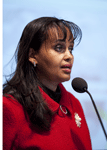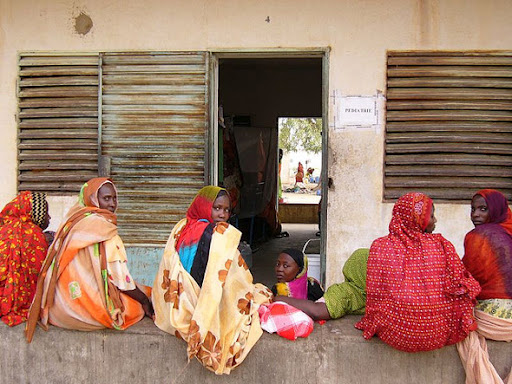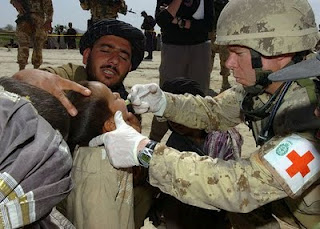-
Watch: Harriet Birungi: Challenges Facing HIV-Positive Adolescents in Kenya
›“Services are not necessarily very adolescent-friendly, so when you get children who are HIV-positive they are likely to face discrimination,” says Harriet Birungi, an associate in the Reproductive Health Program with the Population Council in Kenya, in this interview with ECSP’s Gib Clarke following the Global Health Initiative’s Integrating HIV/AIDS and Maternal Health Services panel.
According to Birungi, medical service censoring and targeted exclusion from schools are among the top challenges facing Kenyan adolescents living with HIV/AIDS. She hopes better support systems and intervention strategies, especially for pregnant individuals, will help medical personnel more quickly identify HIV-positive young adults needing critical medical services. -
Human Resources for Maternal Health
› “Pregnancy is not a disease, a woman should not die of pregnancy…it doesn’t need a new drug…it doesn’t need research – we just need skilled workforce at different levels,” argued Seble Frehywot, assistant research professor of Health Policy and Global Health at George Washington University, at the Global Health Initiative’s second event of the Advancing Policy Dialogue on Maternal Health Series.
“Pregnancy is not a disease, a woman should not die of pregnancy…it doesn’t need a new drug…it doesn’t need research – we just need skilled workforce at different levels,” argued Seble Frehywot, assistant research professor of Health Policy and Global Health at George Washington University, at the Global Health Initiative’s second event of the Advancing Policy Dialogue on Maternal Health Series.
Research shows that increased access to skilled health workers during pregnancy and delivery, including midwives and other practitioners, can significantly reduce maternal mortality in developing countries. One solution to the current human resource crisis is to expand, and in many cases, acknowledge, the skills and responsibilities of non-physician health workers.
Task-Sharing: Who, What, and How
“There are too many preventable deaths…if we look at the data, quality maternal health services are not available,” argued Frehywot, as she presented the following evidence:
There are four common types, or levels, of task-shifting:- Countries that have the highest maternal mortality rates are those that also have the greatest worker shortage
- In Africa, for every 10,000 births, only 2 physicians and 11 nurses or midwives are present at delivery.
- According to the World Health Organization, there needs to be at least 53 skilled health care workers (nurses, doctors, midwives) per 10,000 births to meet Millennium Goal 5 which seeks to reduce maternal deaths by 75 percent by 2015.
1. Doctors to non-physician health clinicians
“All [task-shifting] needs to be done through a sound regulatory framework…it is very important to match tasks that are needed at the ground level with the competency needed to back it up,” maintained Frehywot. Regulatory issues such as the scope of practice, standard of care, training, licensure, and supervision must be addressed to ensure safe and high-quality treatment. Additionally, political buy-in and commitment from the Ministry of Health, medical universities, and professional councils and associations are necessary for long-term development, argued Frehywot.
2. Health clinicians to registered nurses and midwives
3. Nurses/midwives to community health care workers
4. Community health care workers to expert patients
Policies for scaling-up human resources should start at the district level, as these localized hospitals are geographically closest to the need, argued Frehywot. “If one really wants to decrease the maternal mortality ratios, especially by 2015, this is where most of the people live.”
Applying Task-Shifting in Afghanistan “Maternal mortality ratios in Afghanistan are the second highest in the world,” declared Jeffrey Smith, regional technical director for Asia at Jhpiego. In 2002, when Smith arrived in Afghanistan, there were limited health workers, most with out-of-date skills, and no functional schools for training. “The most important decision made early in the reconstruction [of] Afghanistan was that midwives would be the backbone of the reproductive health workforce and they would be empowered with the skills to perform the tasks necessary for provision of basic emergency obstetric care,” shared Smith.
“Maternal mortality ratios in Afghanistan are the second highest in the world,” declared Jeffrey Smith, regional technical director for Asia at Jhpiego. In 2002, when Smith arrived in Afghanistan, there were limited health workers, most with out-of-date skills, and no functional schools for training. “The most important decision made early in the reconstruction [of] Afghanistan was that midwives would be the backbone of the reproductive health workforce and they would be empowered with the skills to perform the tasks necessary for provision of basic emergency obstetric care,” shared Smith.
Making the case for task-shifting, Smith discussed the importance of empowering health workers on the front line so that they may provide services in the most peripheral areas. “Task shifting should not be a temporary fix until we have more doctors,” argued Smith, as this framework disenfranchises a cadre of health workers and fails to build long-term solutions for human resources. Instead, Smith advocated for the “Health Center Intrapartum Care Strategy” that makes midwives the foundation of care and includes strategies for training, staffing, and linkages to the overall health system.
In this post-conflict setting, task-shifting began as an emergency approach. However, it rapidly became a development strategy for professionalizing the workforce and rebuilding the health system. Afghanistan’s Ministry of Public Health was imperative to the success of scaling up midwives as they clearly defined from the beginning what was needed and who would provide care, taking steps to ensure that the midwifery schools maintained legitimacy and received formal accreditation.
“Keep it clinical and keep it local,” shared Smith. The midwifery schools made efforts to recruit individuals from the provincial level, teaching specific life-saving skills applicable in the field. This framework has successfully retained 86% of its graduates, and many of the women report that the program has provided them with a sense of community and ownership.
Building a Sustainable Health Workforce “We invite the maternal health community to take advantage of the incredible momentum that human resources for health is having right now,” shared Pape Gaye, president and CEO of IntraHealth. While there are many issues within the health system that need to be strengthened, Gaye maintained that “we must pick our battles” and advocated for an emphasis on scaling-up the training and availability of midwives.
“We invite the maternal health community to take advantage of the incredible momentum that human resources for health is having right now,” shared Pape Gaye, president and CEO of IntraHealth. While there are many issues within the health system that need to be strengthened, Gaye maintained that “we must pick our battles” and advocated for an emphasis on scaling-up the training and availability of midwives.
In order to scale-up midwives for maternal health we must avoid the same old traps, particularly the lack of donor coordination shared Gaye. “If we do a better job of improving coordination we will start solving the problem.” Additionally, Gaye discussed the implications for training generation “Y,” emphasizing the importance of including new technologies available for training, including PDA’s and e-learning courses.
Performance outcomes and training are the two key pillars of effective scale-up, shared Gaye. Task-shifting also requires legal support and the endorsement from medical associations to help legitimize this new health system framework. “This is not simple work; you really need to have a systems approach. What we seek in the end is good integration. Integration across systems, integration across roles, courses, learning processes, and training for maximum adaptability,” shared Gaye. -
Welcome Back, Family Planning
›January 8, 2010 // By Gib Clarke “When women and girls have the tools to stay healthy and the opportunity to contribute to their families’ well-being, they flourish and so do the people around them,” Secretary of State Hillary Clinton declared today in a speech renewing U.S. support for universal access to reproductive health services and supplies around the world. “Investing in the health of women, adolescents, and girls is not only the right thing to do; it is also the smart thing to do.”
“When women and girls have the tools to stay healthy and the opportunity to contribute to their families’ well-being, they flourish and so do the people around them,” Secretary of State Hillary Clinton declared today in a speech renewing U.S. support for universal access to reproductive health services and supplies around the world. “Investing in the health of women, adolescents, and girls is not only the right thing to do; it is also the smart thing to do.”
Introduced by Melanne Verveer, the first ever ambassador-at-large for global women’s issues, Clinton’s much anticipated statement marked the 15th anniversary of the International Conference on Population and Development (ICPD) and reconfirmed a U.S. commitment to meeting Millennium Development Goals 4 (reducing child mortality) and 5 (reducing maternal mortality and increasing the proportion of births attended by skilled health personnel). Reproductive health and development luminaries Nafis Sadik, UN Foundation President and former Senator Tim Wirth, and newly installed USAID Administrator Rajiv Shah were also in attendance.
Clinton began with a look back to the ICPD—which she called the “first ever global forum that recognized the connection between women’s health, the quality of women’s lives, and human progress on a broader scale”—and the progress since. Declaring that “we have made measurable progress since 1994 in improving the health and the lives of women and children, especially girls,” she cited a number of improvements, including higher child survival rates, use of modern contraceptives, and female education enrollment.
Switching from the past to the present, Clinton described how women and girls continue to bear the brunt of a variety of social ills: they have higher rates of poverty, illiteracy, and malnutrition, and are the most adversely affected by conflict, “from the Congo to Bosnia to Burma.”
After reciting the data on unsafe abortions, STDs and HIV/AIDS, fistulas, and female genital cutting, she declared that “these numbers are not only grim…they are intolerable.” She added, “We can not accept it morally, politically, socially, economically.”
But Clinton’s remarks were not solely focused on health and family planning issues. Echoing arguments made by Nicholas Kristof and others, Clinton described how women’s health and women’s rights directly and significantly impact most major problems in the world, including economics, natural resource conflicts, and national security.
These challenges will require sustained effort and funding, said Clinton, adding that the Obama Administration’s $63 billion Global Health Initiative would address the health challenges of HIV/AIDS and maternal and reproductive health in an integrated manner. All of the administration’s programs would seek to help countries strengthen their own health systems to meet their unique needs—both of their women and girls, but also their populations in general. In all of these efforts, she said including men and boys as “advocates and allies” remains important.
Praise for the speech has been swift—a letter of commendation from a number of foundations was sent to the secretary immediately afterwards.
Maternal and reproductive health have experienced elevated and perhaps unprecedented funding and attention in recent years, especially over the last few months. Secretary Clinton’s impassioned speech is almost certain to keep this momentum alive.
Photo: Courtesy SEIU International -
Making the Connections: An Integration Wish List for Research, Policy, and Practice
›January 3, 2010 // By Geoffrey D. DabelkoNew York Times columnist Nick Kristof is likely a well-known voice to New Security Beat readers. His ground-level development stories from around the world expose a range of neglected issues that usually struggle for mainstream media coverage: maternal health, microcredit, human trafficking, family planning, sanitation, micronutrients, and poverty, among others.
Kristof brought many of these threads together Half the Sky, a book he coauthored with his wife Sheryl WuDunn. I asked about the challenges of addressing these connected problems when I interviewed the couple and two frontline White Ribbon Alliance maternal health practitioners this fall at the Wilson Center.
Now Kristof is asking readers to suggest topics for him to cover in 2010. My suggestions to him are actually a wish list for the wider development community. In short, how can scholars, policymakers, practitioners, and communities better research and analyze these connected topics and then fashion integrated responses? I posted my comment on Kristof’s blog, On the Ground (and I ask your indulgence for the less than polished writing):I’d love for you [Kristof] to explore the challenge of integration from both problem and response perspectives. People in poverty lead integrated lives (just like we wealthier folks do), face connected challenges, and need integrated or multiple responses. Single-sector programs may deliver quicker, more obvious, and/or more countable impacts (or parallel advantages for single-discipline research endeavors). Yet time and time again we see such approaches only partially meeting needs or not meeting them sustainably. There is also a persist danger of undercutting others’ efforts and/or creating high opportunity costs.
These questions topped my wish list to Kristof last night while procrastinating on other writing. What would be on your wish list for Kristof, the development community, or even just New Security Beat? We at the Environmental Change and Security Program (ECSP) would love to hear from NSB readers so we can keep covering the questions that interest you.
So which integrated research, policy analysis, or field-based programs explicitly recognize that trends that appear to be on the periphery are hardly peripheral? At the same time, if programs try to be all things to all people, they can become bloated, unrealistic, and/or unsustainable.
For example, are the Millennium Villages examples of the former or the latter? How about the much smaller programs under the population-health-environment grouping? What went wrong with Campfire programs to cause so many to abandon the approach? Have the loosened restrictions on what constitutes an appropriate PEPFAR intervention addressed this integration problem, or will politics (exclusion of family planning in PEPFAR, for example) mean we cannot capture the full benefits of integration?
And the big Kahuna: how is the rhetoric and analytical argument around the 3Ds (defense, development, and diplomacy) made real and practicable in the field (as in the United States we anticipated early this year the results of the Quadrennial Defense Review (QDR), Quadrennial Diplomacy and Development Review (QDDR), and Presidential Study Directive on Global Development Policy (PSD))?
And finally, does our (read donors’) penchant for measuring impact and quantifying results force us to narrow interventions to the point of missing key connections in cause and effect of the problems we are trying to address? Is there a better mix of defining and measuring success that captures the challenges and benefits of integration? -
‘DotPop:’ Copenhagen’s Collapse: An Opportunity for Population?
›December 22, 2009 // By Gib ClarkeWhile the negotiators failed to reach a comprehensive agreement in Copenhagen, the population and reproductive health community might find a silver lining in the stormclouds that derailed COP-15.
Developing countries’ strong protests of their lack of culpability for the climate problem, on one hand, and the dramatic examples of their vulnerability on the other, have focused the world on the problems of poor people—and on potential solutions, including family planning.
The Case of the Missing “P”
The New York Times’ Andrew Revkin complained that population was the “The Missing ‘P’ Word in Climate Talks,” but PAI’s Kathleen Mogelgaard argues in New Security Beat that “there is encouraging evidence that voices of those advocating for increased attention to the role of population and reproductive health and rights in climate change responses are being heard” in Copenhagen, including new funding from the Danish government for family planning.
At a breakfast last week, luminaries including Gro Harlem Brundtland and IPCC Chairman Rajendra K. Pachauri discussed UNFPA’s latest report, Facing a Changing World: Women, Population and Climate in Copenhagen.
According to lead author Robert Engelman, the report is “helping many more people to see population and climate in a more hopeful light, linked as they are through the right of women to equal standing with men and access to reproductive health care for all.”
Women, Population, and Climate
“Climate change is ultimately about people,” declared Congresswoman Carolyn Maloney at the recent Washington, DC, launch of the report. Though the issues are complex and multi-faceted, Engelman said that the report’s message is “stark and optimistic”: that “women in charge of their own lives” can have positive impacts on change climate mitigation and adaptation.
“Women are more sustainable consumers,” said UNFPA’s José Manuel Guzmán at the launch, noting that in many cases women make buying decisions for their families, so empowering them with information and tools is a wise approach to combating climate change.
Inequitable Impacts
Women – especially poor women – contribute fewer greenhouse gas emissions than men, yet are more vulnerable to the impacts of climate change. Unfortunately, this fundamental inequality is difficult to quantify, since most data sources are not disaggregated by gender. The report recommends improving data quality to better informing policy decisions.
Tim Wirth, president of the UN Foundation and the Better World Fund, noted that women face a “double whammy”: they are already less likely to go to school and to have access to paying livelihoods, and more likely to have HIV. Climate change will only increase the inequity.
People Power
PAI’s Karen Hardee called on the population community to focus their efforts on the next phase of negotiations – adaptation. A recent PAI report found that while 37 of 41 National Adaptation Plans of Action say that population pressures exacerbate the effects of climate change, only six include slowing population growth or addressing reproductive health and family planning as a key priority.
“The focus has been on where and what the impacts of climate change will be,” said Guzman, but the conversation needs to shift to who will be affected, and an analysis of their vulnerabilities and their capacities to adapt.
For real progress to occur, said Engelman, “climate needs to be seen through a more human lens.” -
Integrating HIV/AIDS and Maternal Health Services
›
Integrating maternal health and HIV/AIDS services “includes organizing and providing services that meet several needs simultaneously…focusing not only on the condition, but also the individual,” argued Dr. Claudes Kamenga, Senior Director of Technical Support and Research Utilization at Family Health International, during the first event of the Advancing Policy Dialogue on Maternal Health series co-convened by the Wilson Center’s Global Health Initiative, Maternal Health Task Force (MHTF), United Nations Population Fund (UNFPA), and technical support from U.S. Agency for International Development (USAID). Joined by Michele Moloney-Kitts, assistant coordinator at the Office of the U.S. Global AIDS Coordinator, and Harriet Birungi, a program associate with the Population Council in Kenya, the panelists discussed how integration of HIV/AIDS and maternal health services not only improves health outcomes, but also increases program efficiencies, strengthens health systems, and saves money.
-
Tackling the Biggest Maternal Killer: How the Prevention of Postpartum Hemorrhage Initiative Strengthened Efforts Around the World
›On Friday, November 20th, 120 representatives from the maternal health community, the U.S. and around the world, gathered for an all day meeting at the Woodrow Wilson International Center for Scholars to discuss the report, Tackling the Biggest Maternal Killer: How the Prevention of Postpartum Hemorrhage Initiative Strengthened Efforts Around the World. This report describes the challenges and successes of the U.S. Agency for International Development (USAID) funded Prevention of Postpartum Hemorrhage Initiative (POPPHI).
The five-year POPPHI project was executed through the support of many partners whose main goal was to catalyze the expansion of active management of the third stage of labor (AMTSL) worldwide. The conference convened experts and advocates in the field of maternal health, to share best practices, new innovations, and future challenges for tackling maternal health’s leading killer: postpartum hemorrhage (PPH). Panelists included POPPHI field partners such as International Federation of Gynecology and Obstetrics, The International Confederation of Midwives, the World Health Organization, and international researchers.
Preventing Postpartum Hemorrhage: AMTSL
“We need to work on women postpartum–after birth we leave them,” argued Deborah Armbruster, POPPHI Project Director. Due to the fact that many women in the developing world give birth at home or in local clinics that lack the sufficient resources to prevent postpartum hemorrhaging, approximately 132,000 women die annually. Fortunately, effective and feasible interventions such as those established by POPPHI have been proven to save lives.
Active management of the third stage of labor (AMTSL) includes three factors that, when used together, can avert postpartum hemorrhage, including:1. Administration of uterotonic drugs (including oxytocin – the most preferred drug)
POPPHI’s “BOLD” Approach
2. Controlled cord contraction
3. Uterine massage after the delivery of the placenta
In collaboration with its partners, POPPHI implemented country-level and global programs to scale up AMTSL. Driven by the “BOLD” approach, Armbruster described how the initiative provided overall frameworks and approaches for strengthening PPH interventions by Building on evidence, Obtaining consensus, Linking partners, and Demonstrating to policymakers AMTSL’s feasibility.
Additionally, POPPHI provided learning materials such as toolkits, fact sheets, posters, and guides that were used to train providers and increase their use of AMTSL. A pilot project on Uniject (a single use needle pre-prepared with oxytocin) was also executed in Mali. Uniject was shown to be acceptable and successful with birth attendants there, and the study is now being replicated in Honduras.
Voices from the Field
Representatives from Argentina, Bangladesh, Ghana, Guatemala, Peru, and Mali presented their country results with the POPPHI project–concluding that the initiative served as a catalyst for upscaling AMTSL. Dr. Abu Jamil Faisel, Project Director and Country Representative of EngenderHealth in Bangladesh, discussed how the project helped to break through misperceptions that often prevented women from wanting to use misoprostol. In Ghana, policymakers worked with program managers and drug suppliers to register misoprostol in the country’s essential medicine list and updated guidelines to reflect best practices. While each country’s experiences were unique, the importance of partnerships was common to successfully upscaling AMTSL in all locations.
Partnerships: Critical to Success
Integrating maternal health indicators directly into program design is imperative to upscaling AMTSL, argued Niamh Darcy, Director of POPPHI Monitor and Evaluation. Additionally, Darcy argued that the success of POPPHI is due to the project’s emphasis in working with all levels of partners, particularly facility providers. Working with the supportive supervisors at facilities is necessary according to Darcy because this group is ultimately responsible for executing active management and recording project outcomes.
Identifying African experts who have taken leadership and ownership of the project has been instrumental in POPPHI successfully disseminating results at the regional, national and international levels argued Doyin Oluwole, Director, Africa’s Health in 2010. Partnering with local champions as well as policymakers has enabled many of the country projects to build capacity and upscale AMTSL.
Building on Lessons Learned
“A key lesson we have learned is that, when there is political commitment, AMTSL is rapidly scalable,” stated Lily Kak, Senior Maternal and Newborn Health Advisor, USAID. Changing behaviors and practices takes significant amount of resources and time commitment, however, POPPHI demonstrates that partnerships and research can be used to upscale AMTSL and change policies more efficiently.
Photo: Women wait outside a maternity ward in Chad. Courtesy of Flickr user mknobil. -
U.S. Policy on Post-Conflict Health Reconstruction
›December 8, 2009 // By Calyn Ostrowski Stabilizing and rebuilding state infrastructure in post-conflict settings has been increasingly recognized as critical to aiding the population and preventing renewed conflict. The United States has increasingly invested in rebuilding health systems, and in some cases assisting in the delivery of health services for the first time.
Stabilizing and rebuilding state infrastructure in post-conflict settings has been increasingly recognized as critical to aiding the population and preventing renewed conflict. The United States has increasingly invested in rebuilding health systems, and in some cases assisting in the delivery of health services for the first time.
While global health concerns have recently received significant attention, as witnessed by President Obama’s Global Health Initiative, the importance of health system reconstruction to stabilization efforts remains unevenly recognized. On November 10, 2009, experts met at the Global Health Council’s Humanitarian Health Caucus to discuss investing in health services in the wake of war and the challenges of funding this investment.
“Deconstruction from violence extends beyond the time of war and often leads to severe damage of health infrastructure, decreased health workers, food shortages, and diseases…resulting in increased morbidity and mortality from causes that are not directly related to combat,” shared Leonard Rubenstein, a visiting scholar at Johns Hopkins School of Public Health. Rubenstein argued that while relieving suffering in post-conflict settings should be a sufficient reason to include health reconstruction in U.S. foreign policy, policymakers narrowly define rationales for engagement based on claims that investments increase peace and improve the image of the U.S. government.
Investing in Health Systems Builds State Legitimacy
The evidence for investing in health systems to deter future conflict is limited and this approach is dangerous, according to Rubenstein, because it distorts spending decisions and fails to consider comprehensive capacity development strategies. Additionally, the Department of Defense’s approach of “winning the hearts and minds” is too short-term and neither linked to “system-building activities that are effective and sustainable…nor consistent with advancing the health of the population,” he said.
Instead, Rubenstein recommended that the United States invest in health systems after conflict because it advances state legitimacy. Although additional evidence is necessary, Rubenstein maintains that the promotion of state legitimacy enhances the perception that the government is responding to their long-term needs and encourages local ownership and accountability. Developing health systems in post-conflict settings is complex and cannot be done quickly, he noted, and thus increased financial and human resource capacities will be essential.
Coordination and Transition Funding
“We need to recognize that the U.S. is not the only funder, as there are many stakeholders involved,” argued Stephen Commins, strategy manager for fragile states at the International Medical Corps. Commins argued that there is a “desperate need to coordinate donor funding … both within and across government systems, as well as an increased need for transparent donor tracking systems.”
As countries come out of conflict and start to gain government legitimacy, they need increased support to stabilize conflict and avoid collapse. Transition funding for health systems needs to support both short and long-term efforts, maintained Commins, but unfortunately the donors driving these timelines are often driven by self-interest, not the rights of the individual living in conflict.
Without a transparent donor tracking system, it is hard to demonstrate actual monetary disbursements versus commitments, so Commins called for a system that tracks allocations and spending in real time. These are not our countries, he argued, and responding to health systems in post-conflict settings should be tailored to the country’s needs, not the donor’s. He also called for increased research that describes, over time, the costs for rebuilding and transitioning from international NGO-driven systems to self-sustained governments.
Rebuilding Health Systems in Sudan
George Kijana, health coordinator in southern Sudan for the International Rescue Committee, discussed reasons for why Sudan’s health system remains poor five years after conflict. According to Kijana, the government in Southern Sudan has not been held accountable by its donors, leading to a breakdown in infrastructure and a lower quality of health workers.
Additionally, a majority of the available health data comes from non-state actors that are not easily accessible. Kijana shared that in order for Sudan to move forward, more research and data are needed to help target long-term capacity building projects, as well as short-term interventions that address infant and maternal mortality. While progress is slow, he pointed out encouraging signs of progress, as the Ministry of Health now recognizes their weaknesses and positively engages with its development partners such as the United Nations.
Photo: Romanian Patrol administers medical treatment to Afghan communities, courtesy of Flickr user lafrancevi.
Showing posts from category maternal health.


 “Pregnancy is not a disease, a woman should not die of pregnancy…it doesn’t need a new drug…it doesn’t need research – we just need skilled workforce at different levels,” argued Seble Frehywot,
“Pregnancy is not a disease, a woman should not die of pregnancy…it doesn’t need a new drug…it doesn’t need research – we just need skilled workforce at different levels,” argued Seble Frehywot,  “
“ “We invite the maternal health community to take advantage of the incredible momentum that human resources for health is having right now,” shared Pape Gaye, president and CEO of IntraHealth. While there are many issues within the health system that need to be strengthened, Gaye maintained that “we must pick our battles” and advocated for an emphasis on scaling-up the training and availability of midwives.
“We invite the maternal health community to take advantage of the incredible momentum that human resources for health is having right now,” shared Pape Gaye, president and CEO of IntraHealth. While there are many issues within the health system that need to be strengthened, Gaye maintained that “we must pick our battles” and advocated for an emphasis on scaling-up the training and availability of midwives. “When women and girls have the tools to stay healthy and the opportunity to contribute to their families’ well-being, they flourish and so do the people around them,” Secretary of State
“When women and girls have the tools to stay healthy and the opportunity to contribute to their families’ well-being, they flourish and so do the people around them,” Secretary of State 


 Stabilizing and rebuilding state infrastructure in post-conflict settings has been increasingly recognized as critical to aiding the population and preventing renewed conflict. The United States has increasingly invested in rebuilding health systems, and in some cases assisting in the delivery of health services for the first time.
Stabilizing and rebuilding state infrastructure in post-conflict settings has been increasingly recognized as critical to aiding the population and preventing renewed conflict. The United States has increasingly invested in rebuilding health systems, and in some cases assisting in the delivery of health services for the first time.

